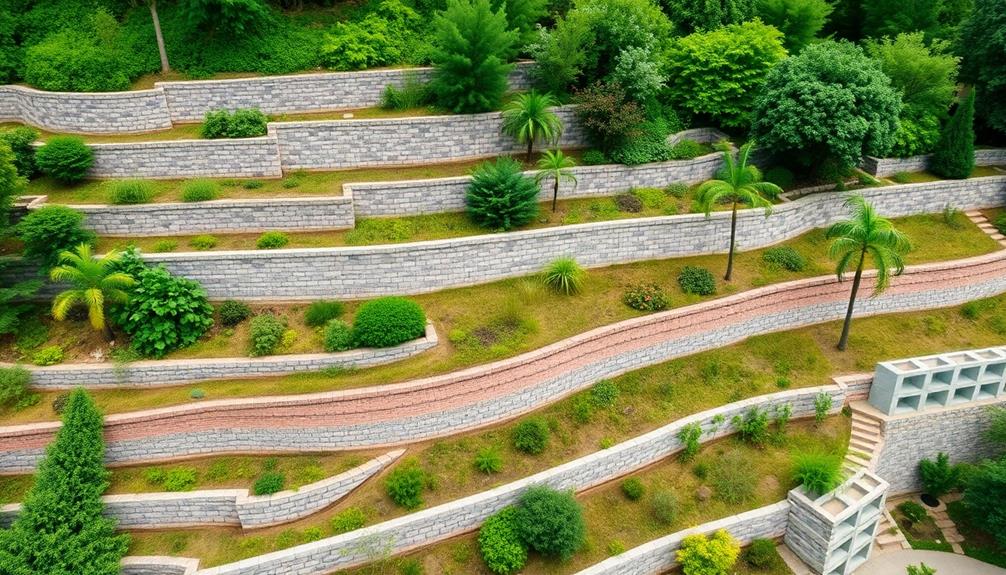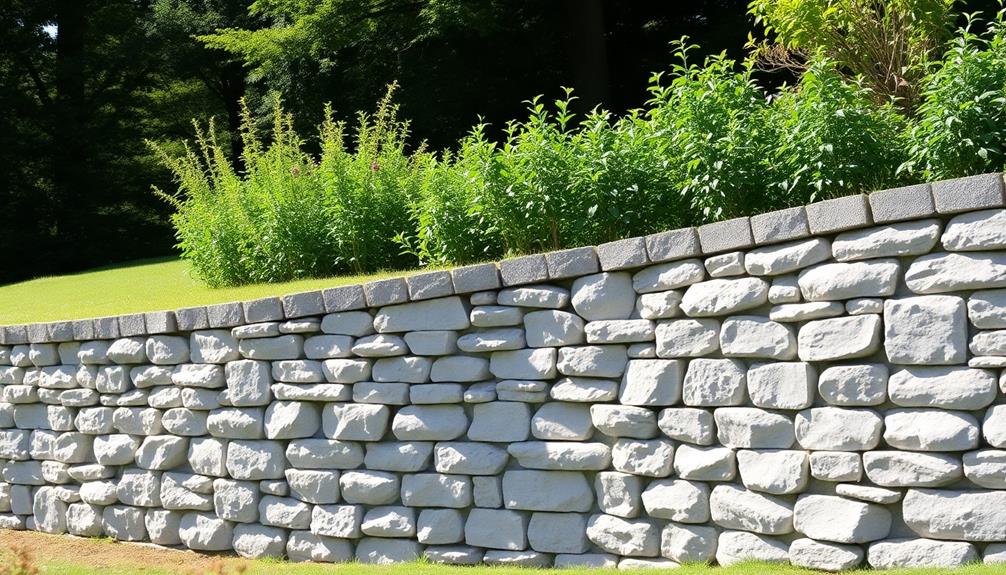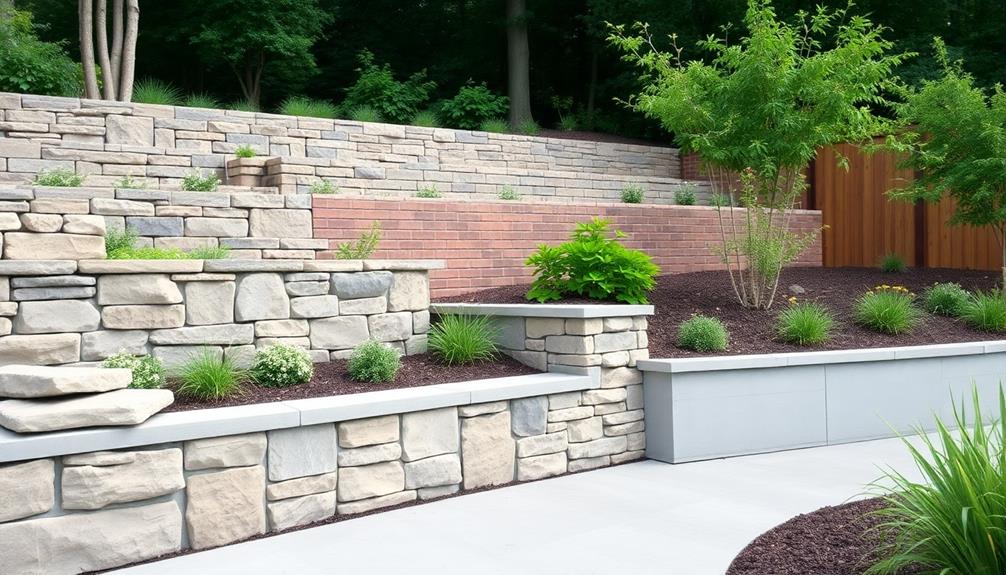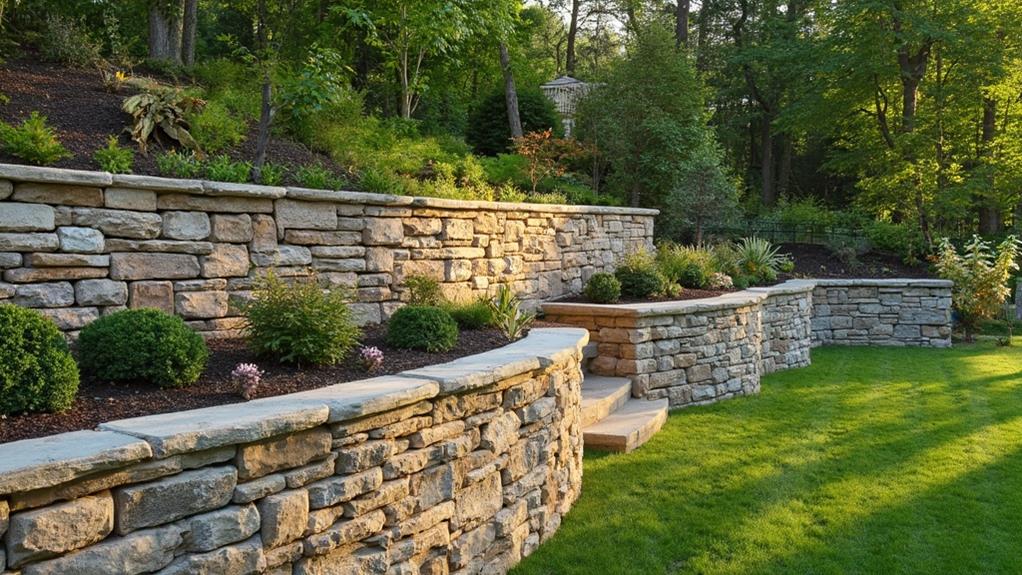Effective construction techniques for retaining walls encompass a variety of materials and methods, each offering unique benefits tailored to specific site conditions and desired aesthetics. Concrete walls, cast-in-place and reinforced, provide exceptional strength against soil pressures, while masonry options like interlocking blocks offer customization and aesthetic versatility. Gabion walls deliver cost-effective, flexible solutions with natural drainage capabilities, and reinforced soil constructions combine geosynthetic elements for high-risk slopes. Timber walls, suited for lower-height applications, present a rustic charm but require careful material treatment. Understanding these techniques enables ideal decision-making to enhance stability and aesthetics in a wide range of settings.
Table of Contents
ToggleWalls Contractor Highlights
- Concrete retaining walls offer high strength and design flexibility, resisting significant lateral soil pressures.
- Masonry walls provide aesthetic versatility through modular design, with moderate soil pressure resistance.
- Gabion walls enable cost-effective natural drainage, needing regular maintenance against corrosion.
- Reinforced soil walls ensure engineered stability for steep slopes, requiring specialized expertise.
- Timber walls present a rustic aesthetic for low-height applications but need periodic replacement.
Primary Purpose of Retaining Walls

Retaining walls serve as critical structures in landscape and civil engineering, primarily aimed at preventing soil erosion, managing slope stability, and enhancing landscape aesthetics.
For example, shoreline restoration efforts often involve transforming shores into beautiful and functional landscapes that protect property from erosion. These structures are expertly designed to hold back soil on steep terrains, thereby effectively reducing erosion risks and maintaining the integrity of the terrain.
Beyond their functional role, retaining walls also contribute to the overall landscape design by allowing for the creation of leveled garden spaces, terraces, and architectural features that transform uneven landscapes into aesthetically pleasing environments.
Preventing Soil Erosion
While addressing landscape challenges, the primary purpose of constructing retaining walls is to effectively prevent soil erosion. This essential function serves to protect and maintain the integrity of landscapes across various environments. Erosion is a natural process, often accelerated by environmental factors such as wind and water flow, that can drastically alter landscapes, destabilize structures, and diminish land usability. Retaining walls act as a critical mechanism against these forces, providing a barrier that holds back soil and prevents it from displacing. By halting the downward movement of earth, they support healthy vegetation growth and maintain the landscape's aesthetic and functional elements.
In residential and commercial settings, where both structural integrity and visual appeal are paramount, retaining walls blend practicality with design, reinforcing terrain against erosion while harmoniously integrating into the surroundings. Utilizing materials like concrete, stone, or wood, each installation can be customized to accommodate diverse soil types, climatic conditions, and topographies. Additionally, the incorporation of drainage solutions within the wall's structure directs water efficiently, preventing water logging and reducing pressure on the wall itself. This multifaceted approach fortifies property against the persistent threat of erosion, fostering an enduring, stable environment for communities to thrive.
Managing Slope Stability
Ensuring slope stability stands at the forefront of retaining wall construction, providing a foundational safeguard against the natural forces that threaten to destabilize terrain. As erosion and gravity work relentlessly, retaining walls serve as critical elements in fortifying landscapes by counteracting these forces.
Crucial to this endeavor is effective design that meticulously considers the unique topography and geological conditions of the intended site. Engineers must conduct thorough site assessments, integrating data such as soil composition, drainage patterns, and loading capabilities to tailor solutions that uphold specific stability demands.
The implementation of proper drainage systems is paramount, as water accumulation behind walls can severely compromise structural integrity. Perforated pipes, gravel backfills, and weep holes collaboratively function to alleviate pressure, ensuring longevity and reliability. Anchoring techniques like cantilevering, terracing, or using reinforced soil structures may also be employed to enhance stability and balance the distribution of forces imposed on the wall.
Community benefits from such construction approaches are manifold. Not only do these methods safeguard infrastructure, but they also maintain natural beauty and land usability, strengthening collective resilience against environmental challenges. By prioritizing slope stability, retaining walls cultivate a harmonious relationship between human developments and the natural landscape they inhabit.
Enhancing Landscape Design
Often overlooked in their structural importance, retaining walls serve a dual purpose by considerably enhancing landscape design. Beyond their role in inhibiting soil erosion and managing slope stability, they add aesthetic value and functional space to outdoor environments.
By creating leveled terraces, retaining walls enable the cultivation of gardens on previously unusable inclines, fostering a sense of belonging with the harmonious integration of natural and built environments. Additionally, their potential to act as seating areas, pathways, or visual barriers enhances their utility while seamlessly weaving intricate design elements into the landscape.
Incorporating materials such as natural stone, brick, or timber can reflect the unique character of one's surrounding environment. Selecting complementary colors and textures, while ensuring structural soundness, can transform these walls into visually striking site features that invite interaction and admiration.
The customization of curves, heights, and lines allows for greater integration into existing landscapes, creating a cohesive and inviting outdoor experience. With careful planning and skilled construction, retaining walls become an ode to the timeless marriage of functionality and beauty, inviting every observer to feel part of a thoughtful, designed space. This harmonious blend ultimately elevates the essence of residential and communal areas alike.
Benefits

The construction of retaining walls offers numerous benefits, including effective erosion control, which helps preserve the landscape by preventing soil displacement and degradation. These structures also enhance structural stability, ensuring safety and longevity in areas prone to landslides or ground shifts.
Erosion Control Advantages
Retaining walls serve as a crucial defense against soil erosion, providing stability and protection to landscapes and structures alike. By strategically halting the movement of soil, these constructions preserve the integrity of both natural landscapes and man-made edifices, safeguarding them against the relentless forces of water and wind. This contributes to both the functional and aesthetic longevity of the environment, allowing communities to thrive amidst the challenges posed by nature.
The benefits of retaining walls in controlling erosion extend beyond mere soil stabilization. They work in harmony with the landscape to mitigate the risks of landslides, prevent the decimation of valuable topsoil, and promote the growth of vegetation that can further anchor the earth in place. By establishing a secure foundation, they create an environment in which ecosystems can flourish, ultimately supporting biodiversity.
- Protection of cherished environments and homes from the ravages of erosion
- Preservation of the earth's essential layers, ensuring fertile grounds for future growth
- Increased longevity of landscapes that offer beauty and refuge to communities
With retaining walls, communities can create harmonious spaces where individuals feel connected, valued, and empowered within their environments, ensuring a legacy of resilience and beauty.
Enhanced Structural Stability
How do retaining walls bolster the structural stability of landscapes and constructions? Retaining walls are crucial in managing soil movement and providing robust support to different types of terrains. Their structural significance lies in preventing landslides and soil erosion by acting as barriers that counterbalance the lateral pressure of slope instabilities. Engineered to provide added strength, these walls facilitate safer, utilization of land, allowing for the seamless integration of human environments with natural topography.
In construction sites, particularly those on sloped terrain, retaining walls provide essential reinforcement, ensuring the longevity and safety of both residential and commercial spaces. By utilizing durable materials like concrete, stone, or treated timber, these structures markedly reduce the risk of soil displacement. Moreover, incorporating modern engineering techniques, such as geogrid reinforcements and proper drainage systems, fortifies their position, enhancing soil stability while extending their lifespan.
For communities, the adoption of retaining walls equates to enhanced safety and prosperity, fostering a sense of security and cohesion among residents. Infrastructures are safeguarded against the forces of nature, promoting both peace of mind and an inclusive sense of place, where landscapes are thoughtfully preserved and managed.
Improved Aesthetic Appeal
Can retaining walls transform landscapes aesthetically while serving functional purposes? Indeed, retaining walls not only enforce structural integrity but also embellish landscapes with charm and elegance. When thoughtfully constructed, these walls can integrate harmoniously into the natural surroundings, transforming unappealing slopes into alluring focal points of residential or commercial properties. With an abundance of design options and materials available, retaining walls offer an impressive canvas to express creativity and personal style in landscaping.
Consider these emotive aesthetic benefits of retaining walls:
- Natural Beauty: Utilizing natural stones or textured finishes, retaining walls can evoke nature's serene elegance, fostering a sense of tranquility and belonging.
- Versatile Designs: From curved, flowing designs to solid, geometric lines, retaining walls can cater to diverse aesthetic preferences, allowing for a personalized touch in outdoor spaces.
- Lush Plant Integration: Through strategic incorporation of vegetation on or around retaining walls, lush greenery can merge with the structure, creating a seamless blend of architecture and nature.
Conclusively, enhanced aesthetic appeal is a notable benefit of retaining walls, allowing property owners to create spaces that are not only structurally sound but also visually inviting, fostering pride and a sense of community connection.
Increased Property Value
A well-designed retaining wall can greatly enhance the value of a property, serving as both a functional necessity and an aesthetic asset. Beyond their primary role in soil stabilization and erosion control, retaining walls strategically contribute to increasing property value by optimizing usability and enhancing visual appeal. Thoughtfully constructed retaining walls can transform unusable or sloped land into flat, accessible areas, creating opportunities for landscaping, garden spaces, or additional outdoor living areas—attributes highly sought after by potential buyers.
The integration of materials such as stone, concrete, or brick into retaining wall designs not only bolsters structural integrity but also accentuates the property's visual appeal, making it more attractive to prospective buyers. A well-crafted design secures these elements complement the existing architecture, harmonizing with the overall aesthetic of the property and community. This attention to detail and consistency fosters a sense of belonging among residents, as their environment reflects a coherent and appealing design.
Moreover, the investment in a high-quality retaining wall signals to potential buyers a commitment to property maintenance and foresight. Buyers perceive the presence of a durable, attractive retaining wall as indicative of a well-cared-for property, leading to increased market interest and value.
Types of Wall Materials

In the domain of retaining wall construction, choosing the appropriate material is pivotal as it can markedly influence both the aesthetic appeal and structural integrity of the wall. Natural stones offer a timeless beauty and blend seamlessly into the environment but may involve higher costs and labor. Concrete blocks, on the other hand, provide versatility and ease of installation, whereas timber presents an eco-friendly option with a warm, natural appearance.
| Material Type | Benefits |
|---|---|
| Natural Stone | Timeless beauty, blends with nature |
| Concrete Block | Versatile, ease of installation |
| Timber | Eco-friendly, natural appearance |
Natural Stone Choices
When it comes to selecting materials for retaining walls, natural stone stands out as an aesthetically pleasing and durable option. With its inherent beauty and enduring strength, natural stone can seamlessly blend into the landscape, making it a favored choice for those seeking to create a timeless and cohesive outdoor environment. The unique textures and colors of stones such as granite, limestone, and sandstone can impart an organic charm that resonates with nature's inherent allure, enhancing the sense of belonging with the surroundings.
Natural stone choices offer significant benefits:
- Timeless Elegance: Natural stone evokes a classic aesthetic that never goes out of style, inviting admiration and a sense of continuity through generations.
- Unmatched Durability: Known for its resilience, natural stone withstands the test of time and the harshest elements, ensuring long-lasting structural integrity.
- Environmental Harmony: As an ecological material sourced directly from nature, stone aligns with sustainability goals and minimizes environmental impact.
Each stone type brings its own narrative and characteristics, offering a palette of possibilities for those who value distinctiveness and ecological responsibility. For communities and homeowners who cherish permanency and a natural integration of structures, natural stone remains a premier choice, offering both functionality and a legacy of beauty.
Concrete Block Options
Concrete block options provide a versatile and economical solution for building retaining walls, accommodating various design and load-bearing requirements. These blocks, crafted from high-quality concrete, offer an impressive balance of strength and durability. Whether in residential landscapes or commercial settings, they stand out for their ability to conform to diverse architectural styles and site-specific challenges. The interlocking design of many concrete blocks simplifies installation, enhancing structural integrity while reducing construction time. Moreover, available in a range of textures and colors, these blocks can seamlessly integrate with the visual aesthetic of any project, offering both practicality and aesthetic appeal.
In terms of engineering, concrete blocks excel due to their innate resistance to harsh environmental conditions, ensuring longevity in even the most demanding climates. Their modular nature allows for the perpetual expansion and modification of structures, making them a favored choice among architects and builders alike. Additionally, their cost-effectiveness does not undermine their robustness; they provide a strong return on investment by requiring minimal maintenance. By choosing concrete block options, stakeholders not only gain a durable solution but also become part of a community that values innovative building practices and sustainable design principles.
Timber Material Benefits
While concrete blocks present a robust and flexible option for retaining walls, timber materials offer a distinct set of advantages that cater to different architectural tastes and environmental considerations. Timber, renowned for its natural aesthetic, seamlessly integrates into landscapes, creating a harmonious connection between constructed spaces and nature. Its organic texture and colors blend well with a variety of landscapes, enhancing the overall appeal of outdoor spaces. Timber's lightweight characteristic also simplifies the construction process, making it an ideal choice for terrain that requires careful consideration of the environmental impact.
Timber retaining walls are particularly suited for residential settings that demand an atmosphere of warmth and inclusion. They provide an inviting ambiance, complementary to homes that aspire to reflect a sense of belonging and closeness to nature. Properly treated timber can resist the ravages of time and weather, prolonging the durability of retaining walls.
- Natural Beauty: Timber exudes warmth and authenticity that resonate with the desire for connection and belonging.
- Environmental Sensitivity: Its renewable nature caters to eco-conscious individuals who prioritize sustainability.
- Ease of Installation: The material's lightweight nature allows for more accessible and less labor-intensive installation processes.
These inherent benefits underscore timber's strength as a viable alternative in retaining wall construction.
Walls Contractor FAQ
How Do You Prevent Water Build-Up Behind a Retaining Wall?
Preventing water build-up behind a retaining wall involves implementing proper drainage solutions, such as installing perforated drain pipes and gravel backfill. These measures promote effective water drainage, ensuring wall integrity and longevity, uniting engineers and builders in shared best practices.
What Are the Best Drainage Solutions for Retaining Walls?
The best drainage solutions involve installing perforated pipes behind the wall, incorporating gravel backfill, and utilizing geotextile fabric to prevent soil erosion. These measures collectively create a durable, community-valued solution to mitigate water accumulation and maintain structural integrity.
How Do You Calculate the Load a Retaining Wall Can Support?
To calculate the load a retaining wall can support, assess soil parameters, wall material properties, and geometry. Implement principles of structural engineering to compute forces. Collaborate with peers and adhere to industry standards for safety and cohesion.
What Are the Common Signs of Retaining Wall Failure?
Common signs of retaining wall failure include visible cracks, tilting or bowing of the structure, water seepage, erosion around the base, and misalignment of wall segments, all of which necessitate immediate attention to maintain safety and structural integrity.
How Often Should Retaining Walls Be Inspected for Maintenance Purposes?
Retaining walls should be inspected annually to guarantee stability and functionality. Community spaces benefit from proactive maintenance as it fosters safety, cohesion, and longevity. Regular assessments prevent costly repairs and maintain the collective investment in shared environments.







